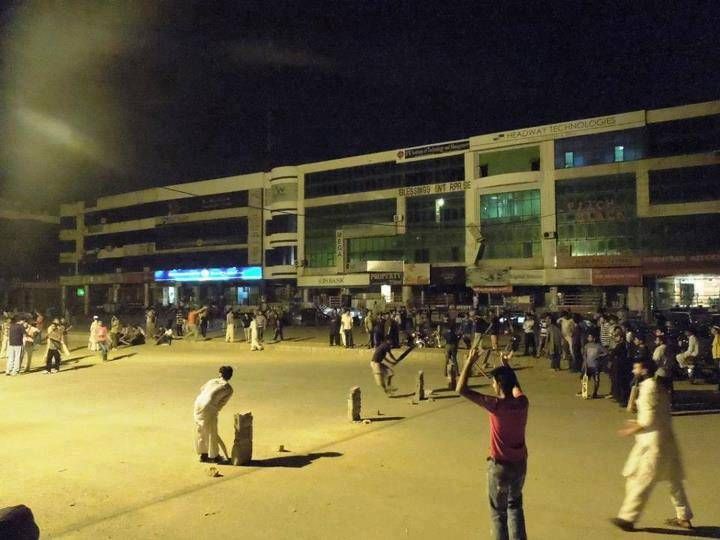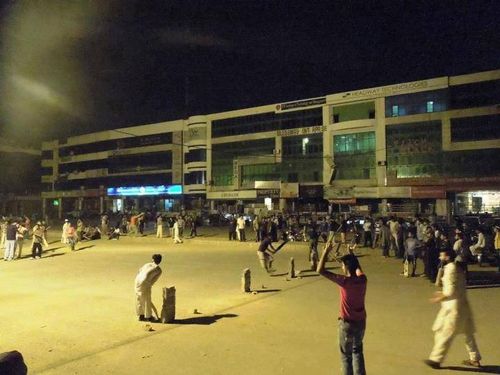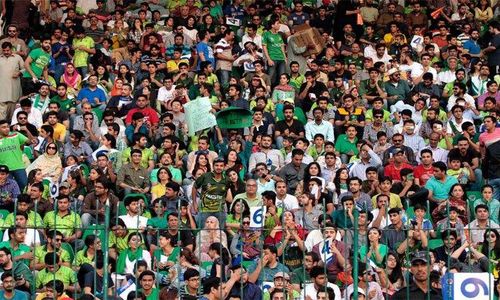
Silence in the Chaos - Cricket in Pakistan

It is 2011. Two years after international cricket is banned in Pakistan. Right across the Punjab University Law College (PULC), Sheikh continues to run his ancestral ‘kebab’ shop. A small kid is helping him out with the chores at the shop. Shahid, a 7-year-old, is serving water and is collecting money from the customers.
It is 6pm on a Friday in the central area of Lahore. Shahid looks at the clock and runs inside the shop to get something. He comes out running with his cricket bat and notifies his dad - ‘Abbu! Khelke aata hu saamne se!’ (Dad, I will be back in no time from right across the street.) His Abbu is busy looking after the customers. A frustrated Sheikh retorts – ‘Jumme ke din bhi khelenge kya yeh log?’ (Do these kids play even on a Friday?)
Shahid then runs carefully across the road and enters the PULC campus. The watchman lets him go at once. I walk across carefully through the traffic and look beyond the gates of PULC. I spot a young kid playing with some 15-year-olds in a small field covered with about 8 inches of grass. The young kid is Shahid and he is running around the garden to collect the ball that is hit by the batsman.
After the game, I had a chance to interact with each of these guys. All they dreamt of was watching a game at The Gaddafi stadium right across the PULC. Kids in other cricket playing countries dream of ‘playing’ at the nearby cricket stadium. These kids just wanted to ‘watch’ an international game of Pakistan! The circumstances, however, portrayed a different story.
This is not only the story of the 7-year-old Shahid, but of every child that ever dreamt of playing for Pakistan. Just as most South American footballers grow up playing the game on beaches and cramped neighborhoods, Pakistani kids get their first taste of competitive cricket on the streets. What made it interesting in the Pakistan cricket history was the fact that almost every major cricketing star from Pakistan seems to have begun playing cricket on the streets. It can be said as the ‘South Asian phenomenon’ but applies more to Pakistan of all the countries.
Multiple cities organized night cricket tournaments in the formative years of the 1980’s. It is said to be the defining moment in the history of Pakistan cricket. The competitiveness among the players increased and that raised the level of cricket. The very famous ‘tape-ball’ cricket was introduced during this time. Every kid of the block in Karachi, Lahore, Peshawar, Islamabad, and Abbottabad started bowling with the half taped tennis balls, every hour of the night cricket.
When we play cricket in India, we are fascinated with how far the ball has been hit by the batsman. But in Pakistan, the craze was to see the half taped tennis ball move. If it moved by a foot, one made the cut to being a good bowler. The greats were in a different league. It was this love and passion for the game that gave Pakistan cricket its heroes. Children started enrolling in academies, clubs and were motivated to play for Pakistan.
That is how cricket grew in Pakistan. The cricket fanatic crowd gathered to see their national heroes every time they took the field. Just imagine, the fascinating sight of Wasim Akram, clad in Green, steaming in to bowl to Tendulkar or a Waugh on a pleasant Friday evening in Lahore. Or a Mustaq or Ajmal bowling to Jayawardene on the turning track in Karachi. That is how Pakistan lived before 2009. The unfortunate event in 2009 turned the world upside down for Pakistan cricket and its fans.
The players were not able to play a home game for six years! Some would argue about Pakistan playing ample games in UAE, but a home game has its own feeling and emotion. For six years, the fans did not get a chance to see their national heroes take the field at home. To put things in perspective India played 23 tests and 73 ODI’s at home, in those six years and that is a lot of cricket.
A Pakistan cricket fan can easily relate to the saying, ‘A sunny morning after a stormy night’. It is the year 2015 and International Cricket has returned to Pakistan. Zimbabwe Cricket, against the advice and warning of its Sports and Recreation commission, decided to tour Pakistan to play 2 T20’s and a 3 match ODI series. What followed the outbreak of the news was an emotional moment in Pakistan’s cricketing history. For the 1st T20I held in Lahore on May 22nd, fans from different parts of the country thronged the Gaddafi stadium to buy tickets.

After six years, the city police had the same old schedule on a Friday in the month of May – crowd control. 60,000 tickets at Lahore were sold out in a couple of hours. The city administrators arranged bus transportation for people to visit Lahore from near-by towns. It was a festive occasion in Pakistan. It was a ‘Jumma’, but a different one this time. No doubt, Gaddafi at Lahore was over-flowing, but so were the emotions of every normal cricket fan sitting in every corner of the world.
Six years of isolation
An important question to think about - Did Pakistan cricket lose a fortune in those six years of isolation? Obviously, the PCB lost a huge fortune because the international teams didn’t want to play, and any home series were organized in the UAE. The officials, at one point, did not see any point in maintaining the dilapidated cricket stands. On a couple of occasions, it was proposed to use the cricket grounds for other entertainment purposes.
However, looking at the bigger picture, all the lost pride of the PCB and the revenue loss can be recovered within no time. But, did Pakistan cricket lose the all-important cricketing talent in those six years? May be yes! Some players from the local academies and clubs could have been playing for Pakistan if the cricket was still alive. Most of the times, when a cricket team is picked for the home series, it is the regulation players who get a chance to showcase their talent.
Their home performances boosts their confidence making them a better international cricketer across the continents. It will be harsh to deny the fact that some of the local budding cricketers did not get a chance to make the cut to the top level. Every time, Pakistan played an international series, the PCB faced the constraint of picking the best of the lot. The not – so best remained the not-so-best forever. The cricket officials and the PCB, now, have to play a very vital role in grooming the talent across the country.
Returning to the emotion of the 1st T20I at Lahore on May 22nd. The crowd went crazy in supporting the home team. Banners saying, ‘Thank you Zimbabwe’ swamped the stadium. One can only imagine the level of happiness of the fans. The match ended with Shahid Afridi hitting a boundary of the last ball to seal the victory for Pakistan. Lahore heaved a sigh of relief, one more time.
There was a silence of emotions settling down among the chaos of the dance and the shouts. Shahid was jumping around with his friends in the stands. Didn’t know his friends called him ‘Lala’ until the last boundary.
This article has been published as part of the SK Featured Bloggers program. The original article was published on the ‘Cricket 361’ blog here.